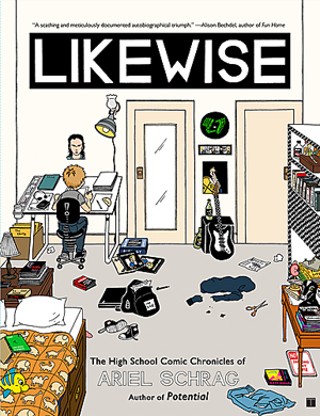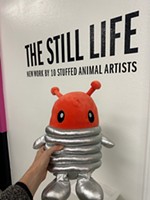Book Review: New in Graphic Novels
An exhaustive and often overwrought tome with an obsessive pen craft as unnerving as Schrag's storm of baby-dyke dilemmas and crises
Reviewed by Wayne Alan Brenner, Fri., May 8, 2009

Likewise: The High School Comic Chronicles of Ariel Schrag
by Ariel SchragTouchstone, 359 pp., $16 (paper)
This is the final third of a trilogy of autobiographical novels – the previous two, Awkward and Definition and Potential, were also published by Simon & Schuster imprint Touchstone – and Likewise, the story of Schrag's senior year of high school, is almost too big to fit into your hall locker.
This book is so big, in part, because everything is in here: all the author's thoughts (expressed in relentless stream-of-consciousness, the galvanizing influence of James Joyce's Ulysses), her incessant self-doubts, her habitual masturbation, her endless cartooning of the world, her curiosity about her own preferences and homosexuality in general, about why her girlfriend dumped her before moving away, about what constitutes the qualities of coolness or "it," about, god damn, everything and everyone she comes into contact with. The girl does go on, until the air is thick with Ariel, the adolescent ground shaggy with Schrag ... and it's all very interesting for a comic-book voyeur but probably not a fun journey for the claustrophobic. (Well, but then neither is Ulysses.)
What adds to and (paradoxically) relieves some of the inner monologue's niggling obsessions is Schrag's visual style: It's a simple, cartoony line, for the most part ... except where the artist expertly uses solid blacks or goes hypertrophic with details backgrounding the characters in a scene. At times, she'll ink a hundred thin lines to represent shadows along a city street, draw the outlines of each animal printed on the bedspread upon which she so frequently fingers herself, invoke vein after vein in the myriad leaves of a park's vast hedge, limn every single blade of grass in a patch of lawn that she and her friends, walking by and deep in conversation, are oblivious to. She's like, what, Cerebus the Aardvark's Gerhard on a coke binge in a room full of rapidographs? There's penciled bits, too, and some instances of watercolors, and sections (illustrating diary entries) rendered in a childlike scrawl.
This is an exhaustive and often overwrought tome about struggling toward adulthood and its vague promise of enlightenment, and the obsessiveness of its pen craft can be as unnerving as Schrag's storm of baby-dyke dilemmas and crises. It's possibly the definition of TMI in its form and content. And, you know, the world is lucky to have such an artifact.
For more reviews of recent graphic novels, check out the Chron's books blog at austinchronicle.com/underthecovers.










